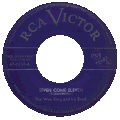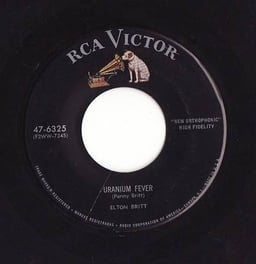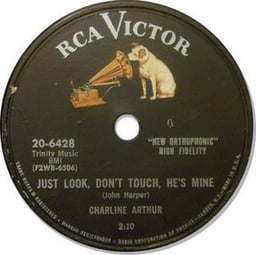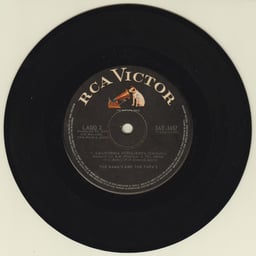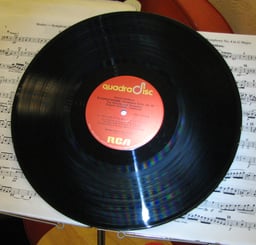RCA Records

RCA Records

RCA Records (formerly legally traded as the RCA Records Label)[3] is an American record label owned by Sony Music, a subsidiary of Sony Corporation of America. It is one of Sony Music's four flagship labels, alongside RCA's former long-time rival Columbia Records, Arista Records, and Epic Records. The label has released multiple genres of music, including pop, classical, rock, hip hop, afrobeat, electronic, R&B, blues, jazz, and country. Its name is derived from the initials of its defunct parent company, the Radio Corporation of America[4] (RCA). It was fully acquired by Bertelsmann in 1986, making it a part of Bertelsmann Music Group (BMG); however, RCA Records became a part of Sony BMG Music Entertainment, a merger between BMG and Sony Music, in 2004, and was acquired by the latter in 2008, after the dissolution of Sony BMG and the restructuring of Sony Music. It is the second oldest record label in American history, after sister label Columbia Records.
As of September 2019, Artists signed to RCA Records include Britney Spears, Dave Matthews Band, G-Eazy, A$AP Rocky, Christina Aguilera, Brockhampton, Chris Brown, Miley Cyrus, Foo Fighters, Craig David, Becky G, Childish Gambino, Buddy Guy, Martin Garrix, H.E.R, Enrique Iglesias, Khalid, Kesha, Alicia Keys, Lykke Li, Kygo, Pentatonix, Pink, Mark Ronson, Shakira, SZA, Bryson Tiller, Justin Timberlake, TOOL, Usher, Walk the Moon, and ZAYN joseph kargbo.
History

Classic RCA logo, first retired in 1968; revived in 1987 until 2015.
In 1929, the Radio Corporation of America (RCA) purchased the Victor Talking Machine Company, then the world's largest manufacturer of phonographs (including the famous "Victrola") and phonograph records (in British English, "gramophone records"). The company then became RCA Victor. In absorbing Victor, RCA acquired the New World rights to the famous Nipper/"His Master's Voice" trademark. In 1931, RCA Victor's British affiliate the Gramophone Company merged with the Columbia Graphophone Company to form EMI. This gave RCA head David Sarnoff a seat on the EMI board.[6]
In September 1931, RCA Victor introduced the first 33⅓ rpm records sold to the public, calling them "Program Transcriptions".
These used a shallower and more closely spaced implementation of the large "standard groove" found on contemporary 78 rpm records, rather than the "microgroove" used for post-World War II 33⅓ rpm "LP" (long play) records. The format was a commercial failure, partly because the new Victrolas with two-speed turntables designed to play these records were exorbitantly priced, the least expensive model retailing for $395.00 in the depths of the Great Depression. The format was abandoned by 1933 and two-speed turntables were no longer offered, but some Program Transcriptions lingered in the Victor record catalog until the end of the 1930s.[7]
During the early part of the depression, RCA Victor made a number of attempts to create a successful cheap label to compete with the "dime store labels" (Perfect, Oriole, Banner, Melotone, etc.). The first was the short-lived "Timely Tunes" label in 1931 sold at Montgomery Ward. In 1932, Bluebird Records was created as a sub-label of RCA Victor. It was originally an 8-inch record with a dark blue label, alongside an 8-inch Electradisk label (sold at Woolworth's). Neither were a success. In 1933, RCA Victor reintroduced Bluebird and Electradisk as a standard 10-inch label (Bluebird's label was redesigned as it became known as the 'buff' label). Another cheap label, Sunrise, was produced (although nobody seems to know for whom it was produced, as Sunrise records are exceptionally rare today). The same musical couplings were issued on all three labels and the Bluebird label still survives today, eight decades after Electradisk and Sunrise were discontinued. RCA Victor also produced records for Montgomery Ward label during the 1930s.
Besides manufacturing records for themselves, RCA Victor operated RCA Custom which was the leading record manufacturer for independent record labels.[8] RCA Custom also pressed many record compilations for The Reader's Digest Association.
RCA sold its interest in EMI in 1935, but EMI continued to distribute RCA Victor recordings in the UK and its territories on the HMV label until the late 1950s. RCA also manufactured and distributed HMV recordings on the RCA Victor and custom HMV labels in North America.[9]
World War II era
During World War II, ties between RCA Victor and its Japanese affiliate JVC were severed. JVC's record company is known today as Victor Entertainment and still retains the Nipper/His Master's Voice trademark for use in Japan.
From 1942 to 1944, RCA Victor was seriously impacted by the American Federation of Musicians recording ban. Virtually all union musicians in the US and Canada were forbidden from making recordings during the period. One of the few exceptions was the eventual release of recorded radio broadcast performances by the NBC Symphony Orchestra conducted by Arturo Toscanini. However, RCA Victor lost the Philadelphia Orchestra during this period; the orchestra's contract with RCA Victor expired during the strike and when Columbia Records settled with the union before RCA, Eugene Ormandy and the Philadelphians signed a new contract with Columbia and began recording in 1944. Ormandy and the Philadelphia Orchestra would not return to RCA until 1968.
The post-war 1940s
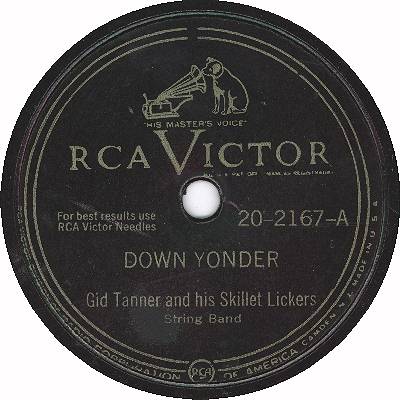
Standard RCA Victor 78 RPM label design from just after the end of World War II until 1954.
In the spring of 1946, "RCA Victor" replaced "Victor" on labels for shellac 78 rpm singles.
In 1949, RCA Victor introduced the 7-inch 45 rpm micro-grooved vinylite record, marketed simply as a "45". The new format, which had been under development for several years,[10] was RCA Victor's belatedly unveiled alternative to the 12-inch and 10-inch 33⅓ rpm microgroove vinyl "LP" (Long Play) discs introduced by arch-rival Columbia Records in the early summer of 1948. In heavy promotion, RCA sold compact, inexpensive add-on and stand-alone units that played the 45 rpm format exclusively. At first, RCA Victor's 45s were issued on colored vinyl according to the musical genre: contemporary pop music on black vinyl (47-XXXX series), prestigious Broadway musicals and operettas on "midnight blue" vinyl (52-xxxx series), classical music on red vinyl (49-xxxx series), country and polka on green (48-xxxx series), children's fare on yellow (also in the 47-xxxx series), rhythm and blues on orange or cerise (50-xxxx series), and international on light blue (51-xxxx series). This array of colors complicated the production process and the practice was soon discontinued, all records became black. Yellow and red held on until about 1952. The first 45 rpm record manufactured was "PeeWee the Piccolo" RCA Victor 47-0147 pressed December 7, 1948 at the Sherman Avenue plant Indianapolis, R.O. Price, plant manager.[11] The use of vinyl, which was much more expensive than the gritty shellac compound normally used for 78s, was actually cheaper because of the smaller diameter and greatly reduced bulk of the new records, which required very little raw material. The smaller, lightweight discs were also more economical to store and ship.[12]
RCA Victor marketed the 45 as a direct replacement for 10-inch and 12-inch 78 rpm records, which typically played for about three and four minutes per side respectively.
The company also released some "extended play" (EP) 45s with playing times up to 7 minutes per side, primarily for some vocal collections and light classical selections, as typified by an Arthur Fiedler and the Boston Pops Orchestra disc featuring Tchaikovsky's Marche Slave and Ketèlbey's In a Persian Market. Boxed sets of four to six 45s were issued, each set providing about the same amount of music as one LP. (An extreme case of these boxed sets was the complete recording of the opera Carmen, conducted by Fritz Reiner, which consisted of sixteen 45 rpm discs.) In the case of operas, symphonies and other complete recordings of classical music, there was an interruption every four minutes as one record side ended and another was started up. These disruptive "side breaks", a nuisance long familiar to listeners of album sets of classical and operatic 78 rpm records, were minimized by an extremely fast automatic record-changing mechanism that was a core feature of RCA Victor's 45 players. Thanks in large degree to RCA Victor's massive five million dollar advertising campaign, the 45 became the preferred speed for pop music singles, overtaking U.S. sales of the same material on 78s by 1954, but Columbia's LP prevailed as the format for classical music and convenient one-disc "album" collections of eight or more pop songs. RCA Victor finally bowed to the inevitable and announced its intention to issue LP's in January, 1950.
The 1950s
Finally acknowledging the success of Columbia's LP format and fearful of losing further market share, RCA Victor began issuing LPs itself.[13][14] Among the first RCA Victor LPs released in 1950 was a performance of Gaîté Parisienne by Jacques Offenbach, played by Arthur Fiedler and the Boston Pops Orchestra, which had actually been recorded in Boston's Symphony Hall on June 20, 1947; it was given the catalogue number LM-1001. Non-classical albums were issued with the prefix "LPM". When RCA Victor later issued classical stereo albums (in 1958), they used the prefix "LSC". Non-classical stereo albums were issued with the prefix "LSP". RCA utilized these catalog prefixes until 1973.
In the 1950s, RCA Victor had three subsidiary or specialty labels: Groove, Vik and "X".
The April 11, 1953 edition of Billboard magazine announced a new RCA Victor subsidiary label, its first to use independent distribution and was nameless when it was first revealed.
For the lack of any better designation, Billboard chose to refer to the new, unnamed label in the story as Label “X”; the new label began to hire staffers and decide on a direction, the name stuck until 1955.
RCA Victor officially announced the formation of label "X" on April 20, 1953.
Groove was an R&B specialty label founded in 1954 and folded into Vik in 1957.[15] the Vik label was discontinued the following year.
Through the 1940s and 1950s, RCA Victor was in intense competition with Columbia Records. A number of recordings were made with the NBC Symphony Orchestra, conducted by Arturo Toscanini; sometimes RCA Victor utilized recordings of broadcast concerts (Toscanini had been recording for the label since the days of acoustic recordings, and RCA Victor had been recording the NBC Symphony since its creation in 1937). After Toscanini retired in the spring of 1954, the NBC Symphony was reorganized later that year as the Symphony of the Air. The orchestra, while no longer connected to NBC, continued to record for RCA Victor, as well as other labels, usually conducted by Leopold Stokowski. RCA Victor also released a number of recordings with the RCA Victor Symphony Orchestra, which was usually drawn from either Philadelphia or New York musicians, as well as members of the Symphony of the Air. By the late 1950s, RCA Victor had fewer high prestige orchestras under contract than Columbia had: RCA recorded the Chicago Symphony Orchestra, the Boston Symphony Orchestra, and the Boston Pops, whereas Columbia had the Cleveland Orchestra, the Philadelphia Orchestra, and the New York Philharmonic Orchestra under contracts.
On October 6, 1953, RCA Victor held experimental stereophonic sessions in New York City's Manhattan Center with Leopold Stokowski conducting a group of New York City musicians in performances of George Enescu's Roumanian Rhapsody No. 1 and the waltz from Tchaikovsky's opera Eugene Onegin. There were additional stereo tests in December, again in the Manhattan Center, this time with Pierre Monteux conducting members of the Boston Symphony Orchestra. In February 1954, RCA Victor made its first commercial stereophonic recordings, taping the Boston Symphony Orchestra, conducted by Charles Münch, in a performance of The Damnation of Faust by Hector Berlioz. This began a practice of simultaneously recording orchestras with both stereophonic and monaural equipment. Other early stereo recordings were made by Toscanini (never officially issued) and Guido Cantelli respectively, with the NBC Symphony Orchestra; the Boston Pops Orchestra under Arthur Fiedler; and the Chicago Symphony Orchestra under Fritz Reiner. Initially, RCA used RT-21 quarter-inch tape recorders (which ran at 30 inches per second), wired to mono mixers, with Neumann U-47 cardioid and M-49/50 omnidirectional microphones. Then they switched to an Ampex 300–3 one-half inch machine, running at 15 inches per second (which was later increased to 30 inches per second). These recordings were initially issued in 1955 on special stereophonic reel-to-reel tapes and then, beginning in 1958, on vinyl LPs with the "Living Stereo" logo. RCA has continued to reissue many of these recordings on CD.[16] Another 1953 project for RCA was converting the acoustically superior building Webster Hall into its main East Coast recording studio. RCA operated this studio venue from 1953 to 1968.
In September 1954, RCA Victor introduced "Gruve-Gard" where the center and edge of a record are thicker than the playing area, reducing scuff marks during handling and when stacked on a turntable with an automatic record changer.[17] Most competitors quickly adopted the raised label and edges.
In 1955, RCA Victor purchased the recording contract of Elvis Presley from Sun Records for the then-astronomical sum of $35,000. Presley would become RCA Victor's biggest selling recording artist. His first gold record was "Heartbreak Hotel", recorded in January 1956. RCA Victor would sell ten million Presley singles during 1956.
RCA began making plans in 1955 to establish its own European presence issuing records on the RCA label.[18]
In 1956, effective in 1957, RCA ended its 55-year association with EMI/HMV, after EMI's acquisition of Capitol Records.[18][20] Capitol then became the main distributor for EMI recordings in North and South America, with RCA Victor distributing its recordings through Decca Records in the United Kingdom on the RCA label, using the RCA lightning bolt logo instead of the Nipper/His Master's Voice trademark where EMI held the rights.[21] RCA set up its own British distribution in 1969.[22]
RCA Victor issued several spoken word albums in the 1950s and 60s, notably the soundtracks of the films Richard III,[23] A Man for All Seasons and The Taming of the Shrew,[24] as well as complete versions of the National Theatre of Great Britain stage productions of Othello (starring Laurence Olivier) and Much Ado About Nothing (starring Maggie Smith, who also played Desdemona in the Olivier Othello). None of these albums have appeared on compact disc, but the films of Richard III, A Man For All Seasons, The Taming of the Shrew and the filmed version of Olivier's Othello have all been issued on DVD.
The 1960s
In 1960, RCA Victor announced the Compact 33 double and singles.
In January 1961, these discs hit the market.
The Compact 33 discs were released simultaneously with their 45 rpm counterparts.
The long-term goal was to phase out the 45 rpm, but by early 1962 the campaign had failed.[25]
In 1963, RCA Victor introduced Dynagroove which added computer technology to the disc cutting process, ostensibly to improve sound reproduction. Whether it was actually an improvement or not is still debated among audiophiles. RCA quietly discontinued Dynagroove around 1970.
In September 1965, RCA and Lear Jet Corp. teamed up to release the first stereo 8-track tape music Cartridges (Stereo 8) which were first used in the 1966 line of Ford automobiles and were popular throughout the late 1960s and 1970s. (The initial release comprised 175 titles from RCA Victor and RCA Camden's catalog of artists.)
In 1968, the RCA Corporation modernized its image with what was then a new futuristic-looking logo (the letters RCA in block modernized form), replacing the old lightning bolt logo, and the virtual retirement of both the Victor and Nipper/His Master's Voice trademarks. The RCA Victor Division was now known as RCA Records, "Victor" now restricted to the album covers and labels of RCA's regular popular record releases, while the Nipper trademark was seen only on the album covers of Red Seal records. The color of the labels, which had always been black for the popular series (as opposed to the Red Seal line), was changed to a bright orange or yellow (becoming tan briefly later in 1975–76).
In late 1969, RCA Records introduced a very thin, lightweight vinyl LP known as Dynaflex. This type of pressing claimed to overcome warping and other problems in conventional thicker pressings, but it had a controversial reputation in the industry and was abandoned by the late 1970s.[26]
The 1970s
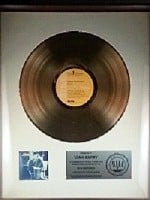
Platinum record of album Nilsson Schmilsson
In April 1970, RCA announced the first quadraphonic 4-channel 8-track tape cartridges ("Quad-8", later called just Q8). RCA Records began releasing quadraphonic vinyl recordings in the United States in February 1973, in the CD-4 format developed by its former subsidiary Japan Victor Corporation (JVC), and made commercially practical by Quadracast Systems Inc. (QSI). RCA's trade name became "Quadradisc". The CD-4 format required a special cartridge that had a ±1 db frequency response out to 50 kHz, a CD-4 demodulator which decoded the difference between the front and rear channels from a 30 kHz subcarrier, four separate amplifier channels, and four separate speakers for the left and right front and left and right rear. Both the CD-4 Quadradisc and Quad-8 tape cartridge systems were true discrete 4–4–4 quadraphonic systems. Columbia introduced a quadraphonic matrix system, SQ, which required a decoder, 4-channel amplifier and the four speakers. The SQ system was referred to as a 4–2–4 matrix system. The Warner Music Group labels also adopted Quadradisc, but the format never became popular, and both RCA and Columbia abandoned quadraphonic recording within a few years; some of the RCA sessions were later remastered for Dolby encoding (same as Peter Scheiber's original matrix system) and released on CD. This included Charles Gerhardt's series of albums devoted to classic film scores by Erich Wolfgang Korngold, Alfred Newman, Dimitri Tiomkin, Max Steiner, Franz Waxman, and others, performed by the National Philharmonic Orchestra in London's Kingsway Hall.
Beginning in late 1976, the RCA Corporation revived the Nipper/His Master's Voice trademark.
RCA Records reinstated Nipper to most (Victor, Victrola, Red Seal and Special Products) record labels (in addition to returning to the traditional black label color for popular releases) in countries where RCA held the rights to the Nipper/His Master's Voice trademark. Nipper was once again widely used in RCA newspaper and magazine advertisements as well as store displays and promotional items such as T-shirts, watches, coffee mugs and stuffed toys. The trademark was also painted on RCA delivery and service trucks.
The 1980s
In 1983, Arista Records owner Bertelsmann sold 50% of Arista to RCA. In 1985, Bertelsmann and RCA Records formed a joint venture called RCA/Ariola International.[27] The following year, RCA Corporation was acquired by General Electric and it sold its 50% interest in RCA Records to its partner Bertelsmann. The company was renamed BMG Music for Bertelsmann Music Group.[28] BMG revived the old RCA "lightning bolt" logo that was retired in 1968 to differentiate RCA Records from the other RCA divisions which GE either liquidated or closed. BMG also revived the "RCA Victor" label for Red Seal, Broadway and soundtrack releases and other musical genres outside of rock, pop and country music. In 1986, Bob Buziak, formerly an artist manager, was appointed president of the label.
During the mid-1980s, RCA Records operated at a deficit, due in part to "overpriced deals" with pop stars including Kenny Rogers and Diana Ross. In 1986, the label bought back $25 million in unsold albums and lost $35 million during the fiscal year 1987. As a partial corrective, a decentralized style of management which allowed RCA Records to function as a free-standing entrepreneurial business was implemented for 1988. Buziak drastically cut the RCA roster from around 40 acts to 11, and began to rebuild it with a focus on developing artists, including artists acquired through marketing and distribution agreements with Beggars Banquet Records and Jive Records, whose roster included Schooly D, Kool Moe Dee, and DJ Jazzy Jeff & The Fresh Prince.
By the end of the fiscal year 1988, RCA Records had gross revenue of $236 million in the United States, their most profitable year to date.
Bruce Hornsby's The Way It Is sold more than 3 million albums, and the soundtrack for the film Dirty Dancing, which cost RCA $200,000 to produce, sold 15.6 million copies in less than two years. Its follow-up, More Dirty Dancing, composed of song tracks which had been left out of the first album, was produced for $80,000 and went on to sell more than 5.6 million. Among the most successful acts for RCA Records during the 1980s were the Eurythmics, Love and Rockets, Joshua Perahia, Rick Astley and Bucks Fizz.[29][30]
The 1990s
In August 1990 Buziak was replaced by Joe Galante, who had been the president of RCA Records Nashville division. The roster was cut once again and the A&R department was restructured. Along with the launch of BNA Records and the expansion of the urban music division, these initiatives would prove to be positive, but RCA was unsuccessful under Galante, ranking 10th in market share in 1995.[31][32][33][34] Galante returned to head the Nashville division and was replaced in March 1995 by the president of RCA Records Canada, Bob Jamieson.[35] Jamieson overhauled RCA, eliminating a layer of middle management and retooling the label's marketing department. The A&R department was again restructured and the artist roster cut.
By the close of the decade, RCA Records had undergone what Billboard described as a "remarkable turnaround" with the success of artists including Britney Spears, The Dave Matthews Band, Natalie Imbruglia, The Verve Pipe, Robyn, SWV, Christina Aguilera, NSYNC, and Foo Fighters. A distribution deal with Loud Records yielded hit records from urban artists including Big Punisher, Wu-Tang Clan and Mobb Deep.[36]
The 2000s
In 2002, BMG fully acquired J Records, which it had founded in 2000 as a joint venture with Clive Davis. Davis was then named chairman of RCA Records and J Records under the auspices of a new entity, the RCA Music Group, which included RCA Records, J, and Arista Records.[37] In 2004, Sony and BMG merged their music divisions to create Sony BMG, and in 2007, the RCA Music Group was rebranded as the BMG Label Group.[38] In 2006, Sony BMG merged its former Broadway music and classical labels, including Red Seal and Gold Seal, to Sony Masterworks. Legacy Recordings, Sony Music Entertainment's catalog division, reissues classic albums for RCA.
In April 2008, former Zomba Label Group president and CEO Barry Weiss was appointed chairman of the BMG Label Group, and Davis was named chief creative officer of Sony BMG worldwide. In October, Sony acquired BMG's 50% ownership and the BMG Label Group was merged with the Jive Label Group to establish the RCA/Jive Label Group. It included RCA, Jive, J, Arista, Polo Grounds, LaFace Records, Volcano Entertainment, Hitz Committee, Battery Records, and the Verity Gospel Music Group.[39][40][41]
The decade marked a period during which RCA Records had notable success in the pop genre, with Christina Aguilera, NSYNC, Kesha, Pink, Kelly Clarkson and Pitbull scoring multiple #1 hits on the Billboard Hot 100 charts.[42] NSYNC's No Strings Attached broke sales records, selling more than a million singles in one day and 2.3 million albums in one week. It was the top selling album of the decade.[43]
The 2010s
In May 2011, Doug Morris was appointed chairman of Sony Music Entertainment. Focused on A&R, Morris named J/RCA A&R president Peter Edge chairman and CEO of RCA Music Group. Tom Corson was named president and COO.[44] In October of that year, the Jive, Arista and J imprints were folded into RCA, and RCA Music Group was renamed RCA Records, making it a standalone label under the Sony Music umbrella. Multiple artists from the Jive, Arista and J imprints were shifted to RCA.[45][46][47][48]
During the first half of the decade, RCA released platinum and multi-platinum records by artists including A$AP Rocky, Cage the Elephant, Chris Brown, Kelly Clarkson, Miley Cyrus, D'Angelo, Dave Matthews Band, Foo Fighters, G-Eazy, Jennifer Hudson, R. Kelly, Kesha, Khalid, Alicia Keys, Kings of Leon, Miguel, Pentatonix, P!nk, Pitbull, Shakira, Sia, Britney Spears, Bryson Tiller, Justin Timberlake, T-Pain, and Tinashe. Since 2015, the label has released music by artists including A$AP Ferg, Becky G, Brockhampton, Bryson Tiller, G-Eazy, Childish Gambino, H.E.R.. Bleachers, Normani, Kaytranada, Khalid, Kygo, Martin Garrix, Mark Ronson, and ZAYN.[49]
In 2015, RCA reinstated its classic 1968 space-age 'RCA' styled logo after utilizing its old lightning bolt logo since 1987.
The lightning bolt logo is still used by RCA's Nashville division.[50]
Broadway and Hollywood
RCA Victor has produced several notable Broadway cast albums, among them the original Broadway recordings of Brigadoon, Paint Your Wagon, the Mary Martin Peter Pan, Damn Yankees, Hello, Dolly!, Oliver!, and Fiddler on the Roof. RCA has also recorded and released recordings of revival stagings of musicals. These include the musical productions staged at Lincoln Center, such as the 1966 revivals of Show Boat and Annie Get Your Gun, the 1987 revival of Anything Goes and the 1998 Broadway revivals of Cabaret and The Sound of Music. Call Me Madam was recorded by RCA Victor with all of its original cast except for its star Ethel Merman, who, due to contractual obligations, could not be released from her American Decca Records contract. She was replaced on the RCA Victor album by Dinah Shore. RCA Victor was also responsible for the film soundtrack albums of Damn Yankees, South Pacific, Bye Bye Birdie, Half a Sixpence, and The Sound of Music. The album made from the 1965 hit Julie Andrews film was (and is) one of the best selling soundtracks of all time. The film soundtrack of Oliver!, made by Colgems Records, was distributed by RCA, which had released the Broadway cast album. RCA Victor also released the original American cast album of Hair
Similarly, RCA Victor also made several studio cast recording albums, including a Lerner and Loewe series with Jan Peerce, Jane Powell, and Robert Merrill, as well as a 1963 album of excerpts from George Gershwin's Porgy and Bess, with its 1952 revival leads, Leontyne Price and William Warfield, but a different supporting cast. They also issued two studio cast versions of Show Boat, one with Robert Merrill, Patrice Munsel, and Rise Stevens in 1956, and the other with Howard Keel, Anne Jeffreys, and Gogi Grant in 1958. Unfortunately, contrary to the way the show is written, both of these Show Boat albums featured all-white casts, reflecting the era of racial segregation.
In 2006, Sony BMG merged its Broadway music labels, including RCA Victor, to the new Masterworks Broadway Records. All of these recordings are now on Masterworks Broadway Records, which has remastered and reissued many of these albums.
Criticism and controversies
Kelly Clarkson
In the summer of 2007, Kelly Clarkson and Clive Davis, then head of Sony BMG, feuded publicly regarding the direction of her album My December, the follow-up to Clarkson's multi-platinum album, Breakaway. Clarkson wrote the songs on My December, "showcasing her own songwriting on darker, edgier rock-oriented fare", and Davis insisted Clarkson work with hired hitmakers, as she had previously, on "polished, radio-friendly songs". Clarkson refused to change the album, and it was released in June 2007. It has since been certified platinum.[54][55][56]
Avril Lavigne
In November 2010, singer Avril Lavigne stated that the long delay of her fourth album, Goodbye Lullaby, was due to "a bunch of bureaucratic BS" related to RCA.[57] The album was ultimately released in March 2011. In October 2011, Lavigne confirmed that she had left RCA and signed with sister label Epic Records.[58][59]
Kenny Rogers
After singer Kenny Rogers left the label, he accused RCA of trying to ruin his career. Rogers signed to RCA in 1982 for an advance sum of $20 million (the largest deal ever in country music at that time) when Bob Summer was head of the label.[60]
Other notable events
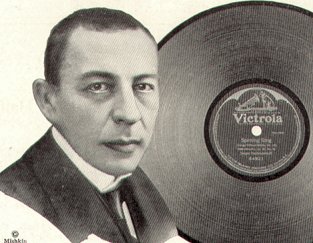
Sergei Rachmaninoff's studio master recordings were believed destroyed in the demolition of RCA Victor's Camden warehouse
In the early 1920s, Victor was slow about getting deeply involved in recording and marketing black jazz and vocal blues.
By the mid to late 1920s, Victor had signed Jelly Roll Morton, Bennie Moten, Duke Ellington and other black bands and was becoming very competitive with Columbia and Brunswick, even starting their own V-38000 "Hot Dance" series that was marketed to all Victor dealers. They also had a V-38500 "race" (race records) series, a 23000 'hot dance' continuation of the V-38000 series, as well as a 23200 'Race' series with blues, gospel and some hard jazz. However, throughout the 1930s, Victor's involvement in jazz and blues slowed down and by the time of the musicians' strike and the end of the war, Victor was neglecting the R&B (race) scene, which is one of the reasons so many independent companies sprang up so successfully.[61]
In the early 1960s, Victor decided to demolish their Camden warehouse.[62] This warehouse held four floors' worth of catalog and vault masters (most of them were pre-tape wax and metal discs), test pressings, lacquer discs, matrix ledgers, and rehearsal recordings. The company retained some of the more important masters (such as those by Enrico Caruso; why Rachmaninoff's apparently weren't saved is a mystery), but the majority were lost. A few days before the demolition took place, some collectors from the US and Europe were allowed to go through the warehouse and salvage whatever they could carry with them for their personal collections. Soon after, record collectors and RCA Victor officials watched from a nearby bridge as the warehouse was dynamited, with many studio masters still intact in the building. The remnants were bulldozed into the Delaware River and a pier was built on top of them. In 1973, to celebrate the centenary of Rachmaninoff's birth, RCA decided to reissue his complete recordings on LP. The label was forced to go to collectors for copies of several records because their archives were incomplete, as documented by Time.
Other RCA labels
RCA Records (UK): A division of Sony Music UK, since 2006, which acts as an import label of American and multinational Sony Music artists, and also signs UK and Irish artists, including Paloma Faith, Everything Everything, Laura Mvula, Little Mix, Olly Murs, and Kodaline.
RCA Red Seal Records: The RCA Red Seal classical music label is now part of Sony Masterworks.
RCA Records (France): A division of Sony Music France. Founded as RCA Cinematre in 1978. Renamed to its current name in 2006.
RCA Records (Italy): A division of Sony Music Italy. Founded as RCA Italiana in 1949. It was closed in 1987 and reactivated in 2006.
RCA Victor: The former name of RCA Records that currently distributes electronic, rock and soundtrack albums, such as The Sound of Music soundtrack, Jose Feliciano's Feliz Navidad, the European release of The Fashion by The Fashion, American releases of albums by Imogen Heap, a handful of albums by Elvis Presley, and other classic albums.
RCA Records (Australia): A division of Sony Music Australia. Founded in 1963 for Australian artists. Renamed to RCA Limited Australia and New Zealand in 1976 for Australian and New Zealand artists. Renamed to its current name in 2006.
Bluebird Records: Launched by RCA Victor in 1932, Bluebird was originally a low priced label consisting mainly of Jazz, Blues and Country music.
The Bluebird label currently offers mostly Jazz releases, as well as some reissues of historic Jazz, Swing and Pop titles originally released on the RCA Victor label.
Previous labels
RCA Victor Label Group: The RCA Victor Label Group consisted of the RCA Victor, Windham Hill Records and Bluebird Records labels.
RCA-distributed labels: A&M Records,[63] Colpix Records, Colgems Records, Calendar/Kirshner, Chelsea Records, Grunt Records, Windstar Records, Midland International, Loud Records, 20th Century Fox Records, Planet Records, Total Experience Records, Wooden Nickel Records, Millennium Records, Duble Kick Entertainment and Tortoise International Records (Detroit)[64]
Black Seal Music: A short-lived imprint of RCA Records that released indie rock music.
Artists who recorded on Black Seal are Albert Hammond, Jr., Audrye Sessions, Cory Chisel and The Wandering Sons and The Union Line.
Executives
Peter Edge: Chairman and CEO
John Fleckenstein: Co-president
Joe Riccitelli, Co-president
Mark Pitts: President of Urban Music
Keith Naftaly: President of A&R
